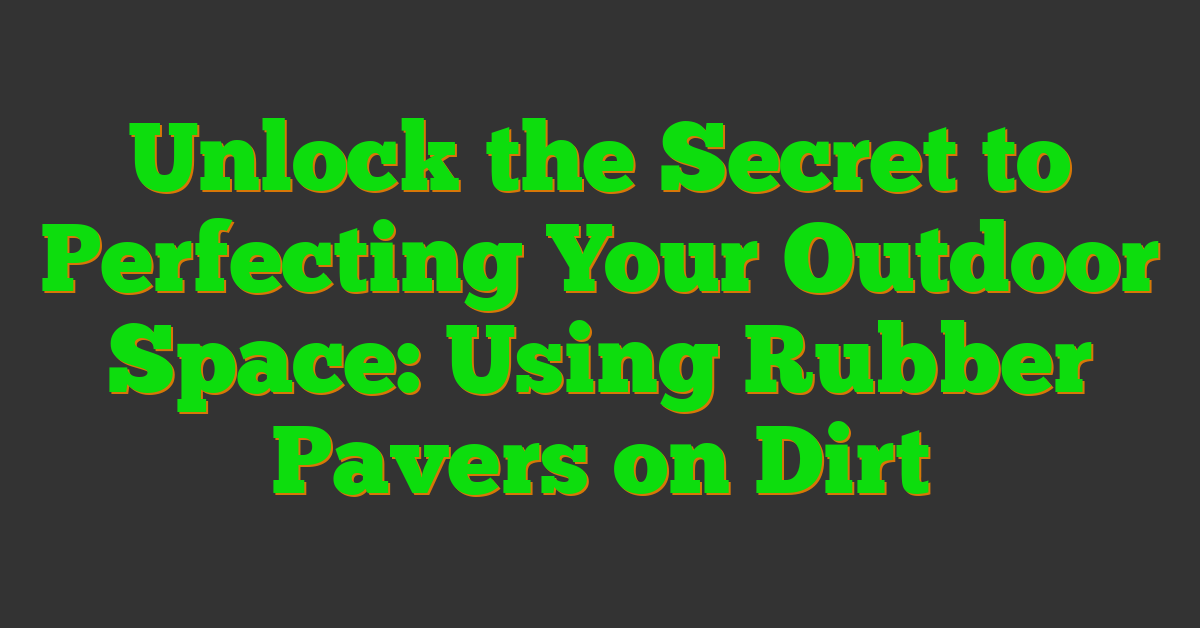Thinking of sprucing up your outdoor space with rubber pavers but unsure if they can be used on dirt? We’ve got you covered! Rubber pavers are a versatile option for transforming your backyard, patio, or garden.

When it comes to using rubber pavers on dirt, there are a few key considerations to keep in mind. From enhancing the aesthetics of your outdoor area to providing a comfortable and durable surface, rubber pavers offer a range of benefits.
Join us as we explore the possibilities of using rubber pavers on dirt and discover how these eco-friendly and easy-to-install pavers can elevate your outdoor living space.
Understanding Rubber Pavers
As landscape designers, we often recommend using rubber pavers to enhance outdoor spaces like backyards, patios, and gardens. Let’s delve deeper into the features and benefits of these versatile paving solutions.
The Basics of Rubber Paver Material
When it comes to rubber pavers, we are drawn to their unique composition. These pavers are typically made from recycled rubber tires, providing them with exceptional durability and resistance to harsh weather conditions. The texture of rubber pavers offers a slip-resistant surface, making them an ideal choice for various outdoor applications.
Advantages of Rubber Pavers Over Traditional Materials
One of the key advantages of rubber pavers, from our experience, is their eco-friendly nature. By repurposing old tires, we contribute to sustainability efforts while creating functional and appealing outdoor spaces. Additionally, rubber pavers are easy to install, requiring minimal expertise and tools, making them a cost-effective choice for homeowners looking to revamp their outdoor areas.
Preparing Dirt Surfaces for Rubber Pavers
Assessing Soil Conditions
As landscape designers, we know that ensuring the right soil conditions are crucial before installing rubber pavers on dirt. Before any work begins, we assess the soil to check for factors like drainage, compaction, and stability. Proper drainage is essential to prevent water from pooling beneath the pavers, which could lead to shifting or uneven surfaces over time. Compacted soil can cause issues with stability and drainage, so aerating the soil may be necessary to improve its structure and prevent issues down the line.
Ground Preparation Steps
When preparing dirt surfaces for rubber pavers, our first step is to clear the area of any debris, rocks, weeds, or vegetation. This ensures a clean and level base for the pavers. Next, we compact the soil to create a stable foundation for the pavers to sit on. Adding a layer of gravel or sand can further enhance drainage and stability. It’s crucial to ensure that the ground is level to prevent any unevenness in the final paver installation.
By following these ground preparation steps, we can create a solid foundation for rubber pavers on dirt, ensuring a long-lasting and visually appealing outdoor space for our clients.
Installation of Rubber Pavers on Dirt
Laying the Foundation
To install rubber pavers on dirt successfully, our first step is to lay a solid foundation. We always begin by ensuring the dirt surface is clear of any debris or vegetation. It’s crucial to have a clean and even surface to work with before laying the pavers.
Next, we focus on compaction. Compact the dirt surface thoroughly to create a stable base for the rubber pavers. This step is essential to prevent shifting or sinking of the pavers over time. A compacted surface provides better support and enhances the longevity of the installation.
In some cases, we may recommend adding a layer of gravel or sand to improve drainage and stability. This additional layer helps in preventing water pooling and enhances the overall durability of the installation. By paying attention to these details during the foundation stage, we ensure a solid base for the rubber pavers.
Aligning and Placing the Pavers
Once the foundation is prepared, the next step is aligning and placing the rubber pavers. We start by laying out the pavers in the desired pattern or design. Proper alignment is key to achieving a professional and visually appealing result.
When placing the pavers, ensure they fit snugly together without gaps. This not only enhances the aesthetic appeal but also improves the stability of the overall installation. Take care to align the edges of the pavers neatly to create a seamless look that enhances the outdoor space’s visual appeal.
As you place each paver, press it firmly into the compacted dirt base. This ensures a secure fit and prevents any shifting once the installation is complete. By paying attention to detail during the alignment and placement process, we create a high-quality finish that withstands the test of time.
Ensuring Proper Drainage
Proper drainage is essential when installing rubber pavers on dirt. We always consider the slope of the surface to ensure water flows away from the area efficiently. This prevents water from pooling around the pavers and helps maintain the integrity of the installation.
Incorporating a slight slope during the installation process allows water to drain naturally, reducing the risk of erosion or water damage. By ensuring proper drainage from the start, we guarantee a long-lasting and low-maintenance outdoor space that remains visually appealing for years to come.
Maintenance and Durability of Rubber Pavers on Dirt
Cleaning and Upkeep
When it comes to maintaining rubber pavers installed on dirt, our focus is on simplicity and practicality. We recommend regularly sweeping the pavers to remove debris like leaves, dirt, and any other particles that may accumulate on the surface. This straightforward maintenance routine helps prevent staining, mold growth, and the development of slippery conditions. For tougher stains or dirt build-up, a gentle cleaning solution mixed with water can be used to scrub the pavers effectively. Avoid harsh chemicals that can damage the rubber material and opt for environmentally friendly options.
To maintain the aesthetic appeal of your outdoor space, periodic inspections are essential. Check for any signs of shifting or uneven settling of the pavers, which can be addressed by adding more compacted dirt underneath or readjusting the placement of the pavers. By staying proactive in your maintenance efforts, you can extend the lifespan of your rubber pavers and keep your outdoor area looking pristine.
« Discover the Surprising Lifespan Secrets of Pavers! Expert Tips Revealed
Longevity and Wear Resistance
Our experience as landscape designers has shown us that properly installed rubber pavers on dirt can offer impressive longevity and wear resistance. When installed on a solid, well-prepared dirt base with proper drainage, rubber pavers can withstand the elements and heavy foot traffic exceptionally well. The inherent flexibility of rubber allows the pavers to adapt to minor shifts in the ground, reducing the risk of cracking or breakage over time.
Rubber pavers are known for their durability, making them an excellent choice for outdoor spaces that require low maintenance and long-lasting solutions. With proper care and installation, these pavers can provide years of reliable performance, retaining their color and structural integrity even in challenging weather conditions. As landscape designers, we believe that investing in high-quality rubber pavers for your outdoor projects can result in a durable and visually appealing space for years to come.
Design Ideas Using Rubber Pavers on Dirt
Landscaping with Rubber Pavers
When it comes to landscaping with rubber pavers on dirt, the possibilities are endless. We can create beautiful pathways, patios, or even entire outdoor living spaces using these versatile pavers. By strategically placing rubber pavers, we can define different zones within the landscape, enhancing both functionality and aesthetics.
Rubber pavers offer a soft and slip-resistant surface, making them ideal for creating safe and inviting outdoor areas. Whether we want to design a cozy seating area in the garden or a vibrant play space for children, rubber pavers can help us achieve these goals with style and practicality.
Creative Patterns and Colors
One of the most exciting aspects of using rubber pavers in landscaping is the wide range of patterns and colors available. From classic brick patterns to modern geometric designs, we can unleash our creativity and design unique outdoor spaces that reflect our personal style.
By mixing and matching different colors and patterns, we can create visually appealing accents, borders, or focal points within the landscape. Whether we prefer a cohesive look or a bold statement, rubber pavers allow us to experiment with various combinations to achieve the desired effect.
With our expertise in landscape design and the versatility of rubber pavers, we can transform any outdoor area into a captivating and functional space that resonates with our clients’ preferences and lifestyle.
Conclusion
We’ve delved into the world of rubber pavers on dirt surfaces, uncovering the key aspects of installation, maintenance, and design possibilities. These versatile pavers offer a soft, slip-resistant solution for creating inviting outdoor spaces like pathways and patios. With a range of colors and patterns, the creative potential is endless, allowing for unique and personalized designs. By combining our landscaping expertise with the durability of rubber pavers, we can transform outdoor areas into functional and visually stunning landscapes that cater to individual preferences and lifestyle needs. Let’s pave the way to a vibrant outdoor oasis with rubber pavers on dirt!










